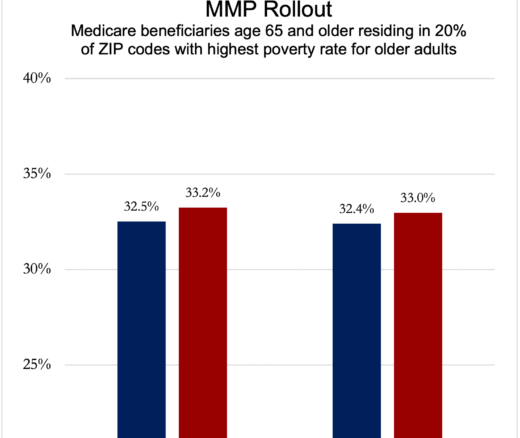
Integrated Care Plans Didn’t Boost Medicaid Enrollment for the Poorest Seniors
Chart of the Day: Medicare-Medicaid Plans—Created to Streamline Care for Dually Eligible Individuals—Failed to Increase Medicaid Participation in High-Poverty Communities
Health Care Access & Coverage | Improving Care for Older Adults
Blog Post

Produced in conjunction with the Population Aging Research Center at the University of Pennsylvania.
Most Americans, when asked, say they would prefer to die at home, and yet many die in a hospital or nursing home, which may lead to unwanted treatments. Hospice can help facilitate end-of-life care that is focused on the individual’s needs and wishes of the patient and their families, but often its use is delayed until the last few days or weeks of life, if it is used at all.
But the situation is improving for Americans. Recent research found that death in hospitals and nursing homes decreased between 2003 and 2017 while death at home and in hospice facilities increased.
Our recent study in Health Services Research examined factors that may be driving these improvements. In particular, we looked at whether insurance design may be playing a role in the changing patterns of end-of-life care. There has long been concern that traditional fee-for-service Medicare (TM) incentivizes over-utilization of health care. But an increasing number of older Americans are enrolling in the alternative, capitated Medicare Advantage (MA) plans. Launched in 2003, Medicare Advantage now covers about 42% of Medicare-qualifying Americans.
Using Medicare administration and claims data for 2012 and 2014, we examined the effects of MA enrollment on patterns of end-of-life care in hospital and hospice settings among Medicare decedents. We examined site of death, place of care, and care intensity during hospitalization. To overcome selection bias—healthier beneficiaries tend to enroll in MA—we used an analytical approach that took advantage of a policy that creates differences in payment rates by county population.
Our findings showed that MA is indeed influencing use of end-of-life care. Enrollment in MA decreased hospitals as the site of death by 11.0 percentage points. Furthermore, it increased hospice use by 6.2 percentage points at time of death and 7.7 percentage points in the last 30 days of life.
However even within MA, we identified inefficiencies in care delivery, especially once a person was hospitalized. Compared to TM, MA enrollment increased use of intensive care by 6.7 percentage points and noninvasive mechanical ventilation by 9.2 percentage points during end-of-life care. Additionally, we found no difference in the hospitalization rates for TM and MA enrollees during the last 30 days of life.
These results are particularly timely as policymakers explore ways to better match patient preferences with the care they receive at the end of life. Interestingly, hospice benefits for MA enrollees are always paid on a fee-for-service basis, and MA plans are not responsible for these services nor do they oversee them, potentially incentivizing MA plans to refer patients earlier to hospice. However, prior research found that fewer MA enrollees are discharged alive from hospice than TM enrollees, suggesting the MA carve-out may not be necessarily associated with inappropriate referrals.
The Centers for Medicare and Medicaid Services (CMS) is currently considering implementing “hospice carve-in” to MA, which would give MA plans full financial and care responsibility for their enrollees at the end of life. The move to a “hospice carve-in” started incrementally in 2021, when CMS began testing the model in 9 MA organizations in 206 counties, and increased to 13 MA organizations operating in 461 counties in 2022. Should the payment model shift towards value-based insurance in hospice care, we believe it will be important to consider quality metrics in order to achieve the intended benefits. Our work suggests that the shift could lead to further increases in hospice accessibility and that resulting outcomes might be decreases in both care intensity as well as in potentially burdensome transitions. More importantly, it might improve care integration, potentially allowing plans to provide more patient-centered care that improves quality of life at the end of life.
The study, Effects of Medicare Advantage on Patterns of End-of-Life Care Among Medicare Decedents, was published on February 13, 2022, in Health Services Research. Authors were Sungchul Park, Joan M. Teno, Lindsay White, and Norma B. Coe.




Chart of the Day: Medicare-Medicaid Plans—Created to Streamline Care for Dually Eligible Individuals—Failed to Increase Medicaid Participation in High-Poverty Communities
Research Brief: Shorter Stays in Skilled Nursing Facilities and Less Home Health Didn’t Lead to Worse Outcomes, Pointing to Opportunities for Traditional Medicare

How Threatened Reproductive Rights Pushed More Pennsylvanians Toward Sterilization

Abortion Restrictions Can Backfire, Pushing Families to End Pregnancies

They Reduce Coverage, Not Costs, History Shows. Smarter Incentives Would Encourage the Private Sector
Research Brief: Less Than 1% of Clinical Practices Provide 80% of Outpatient Services for Dually Eligible Individuals